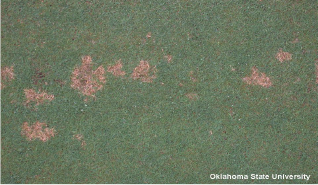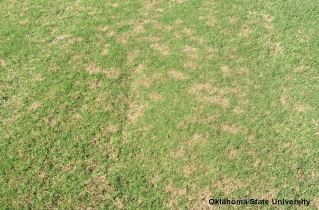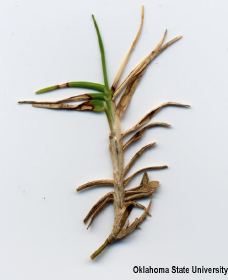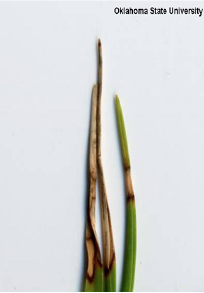Dollar Spot of Turfgrass
Dollar spot is a common foliar disease that occurs on most types of turfgrasses (bentgrass, bermudagrass, bluegrass, buffalograss, fescue, ryegrass, and zoysiagrass) throughout Oklahoma. However, this disease is often most severe on turfgrass in residential lawns maintained under a low nitrogen fertility program and on bentgrass golf greens. In Oklahoma, dollar spot is most prevalent in late spring and early fall when high humidity and cool nights favor the formation of dew that is present on turfgrasses for extended periods.
Symptoms and Signs
Symptoms of dollar spot vary with turfgrass species and management practices. On closely mowed turfgrass, such as bentgrass golf greens, the characteristic symptoms of dollar spot are small, circular, straw‑colored, sunken patches that rarely exceed two to three inches in diameter (Figure 1). If the disease becomes severe or is left un-managed, individual spots may coalesce forming larger, irregular patches of blighted turfgrass and plants will eventually die. On residential lawns and taller turfgrasses, symptoms appear in irregularly shaped, bleached patches ranging from four to six inches or more in diameter (Figure 2). Patches may coalesce to cover large areas.
Individual infected leaves exhibit lesions (spots) that are first chlorotic (pale green or yellow), then water‑soaked, and finally a bleached straw color (Figure 3). Dollar spot lesions are characteristically bounded by a tan to reddish-brown margin (Figure 4). However, these borders do not usually occur on annual bluegrass. Leaf lesions can expand extending across the entire leaf, resulting in girdling of blades and dieback from leaf tips. Individual leaf blades may have a single lesion, many small lesions, or be entirely blighted. Leaf symptoms can be confused with those caused by Pythium blight and Rhizoctonia brown patch.
In the early morning when dew is present on grass blades and the pathogen is active, a white, cottony, growth (mycelium) may be seen in the affected patches. The white, cottony growth resembles that of other fungi such as Pythium and Rhizoctonia or can be confused with windborne seeds of various trees (e.g. cottonwood). The growth rapidly disappears as leaves dry.
Figure 1. Symptoms of dollar spot on a creeping bentgrass putting green.
Figure 2. Symptoms of dollar spot on a residential lawn planted with bermudagrass.
Figure 3. Leaf spot symptoms bleached leaves characteristic of dollar spot on bermudagrass
Figure 4. Leaf spot symptoms with tan to reddish-brown margins.
Casual Agent and Disease Cycle
Sclerotinia homoeocarpa has been the name most frequently used for the fungus that causes dollar spot. However, recent studies have shown that the fungus most likely is in the genus Rutstroemia. The dollar spot fungus overwinters as dormant mycelium in infected plants or as darkly pigmented survival structures (stromata) that form on the margins of lesions from previous epidemics of disease. The production of spores is considered extremely rare and not likely in North America. Therefore, spread of this fungus is restricted to movement of infected leaf debris by equipment, people, animals, water, or wind. Epidemics are typically initiated when night temperatures exceed 50°F and prolonged periods of continuous leaf wet-ness (10 to 12 hours) exist. When these conditions are met, the fungus will grow on the surface and directly penetrate the leaf blade resulting in the formation of a lesion. As the fungus continues to colonize and kill turfgrass tissues, lesions will be-come more pronounced. Continued conducive weather will favor spread of the fungus to adjacent plants and development of disease foci into characteristic patches of dead turf. These events will continue until weather conditions become unfavorable for the disease.
In Oklahoma, the disease is most active in early spring (April to June) and late fall (October to November); however, if weather conditions are conducive the disease can occur at anytime during the growing season. Favorable environmental conditions include humid weather with warm days and cool nights that result in heavy dews. A temperature range of 50°F to nearly 90°F can encourage growth of the fungus, with greatest activity for infection occurring between 60°F and 70°F. The disease can remain active even at high temperatures but will typically slow or cease when daytime highs exceed 90°F. Turfgrass grown under low nitrogen fertility is more prone to dollar spot development. Turfgrass that is drought-stressed, excessively irrigated, has low air movement above the canopy, subjected to low mowing heights, and/or has excessive thatch buildup will be more prone to dollar spot. Extended periods of wet, overcast weather can lead to severe epidemics of dollar spot on grasses susceptible to the disease. Epidemics under these conditions are even more severe when soil is excessively dry.
Disease Management
Cultural Management
Grasses, especially bentgrass used on golf greens, vary greatly in susceptibility to dollar spot. Selecting resistant turfgrass varieties will reduce the incidence and severity of the disease. Contact your local Extension office for a list of suita-ble dollar spot resistant cultivars.
Activities which minimize the duration of leaf wetness can greatly reduce infection by the fungus. Practices such as early morning irrigation, removing dew, and increasing air flow across the turf will help suppress disease. Irrigate based on the moisture status of the soil, not on a calendar basis. A soil moisture probe can be helpful for maintaining adequate moisture in the root zone without over irrigating. When water is required, apply a sufficient amount to wet the soil and then water as infrequently as possible without causing moisture stress between watering (Consult http://sip.mesonet.org/ for proper irrigation recommendations for your specific situation). Avoid frequent applications of small amounts of water, unless the water is used briefly to remove morning dew. Do not water in the late afternoon or evening.
Routine thatch removal and aerification can also reduce the incidence and severity of disease. Maintain a moderate to high nitrogen fertility program appropriate to the turfgrass species, during periods favorable for dollar spot development. For bermudagrass, a total of five pounds actual nitrogen (N) per 1,000 square feet per year should be applied as five one‑pound N per 1,000 square feet split applications in May, June, July, August, and September. Do not apply nitrogen after September 15, as this may increase bermudagrass susceptibility to winter injury and spring dead spot disease development. An additional one to three pounds N per 1,000 square feet per year may be needed on high maintenance areas.
For cool‑season turfgrasses (bentgrass, bluegrass, fescue, and rye), four pounds N per 1,000 square feet per year should be applied as one pound N per 1,000 square feet applications in March, May, September, and November. Over fertilization should be avoided as other diseases can be promoted by excessive nitrogen levels (e.g. brown patch and Pythium blight). Mow the turfgrass regularly at recommended heights and only when the turfgrass is dry. For more information about warm and cool-season turfgrass fertilization programs in Oklahoma, consult the Oklahoma Cooperative Extension Service fact sheet HLA-6420, “Lawn Management in Oklahoma.”
Chemical Management
Few effective fungicides are now available over the counter for the homeowner which can be used for dollar spot management. However, many effective fungicides are available to the professional turfgrass management community for dollar spot control. Fungicide resistance has been a chronic problem for this pathogen. For chemical control to be effective, different fungicide chemistries should be alternated and applied in the early spring and fall before disease development or when the disease is first evident. Fungicides should not be the only management tool. An integrated pest management (IPM) program combining cultural and chemical management, and considering other potential pests, should be used to manage dollar spot effectively without encouraging other turfgrass pest problems. For suggested fungicides, rates, and application intervals, refer to the current OSU Extension Agents’ Handbook of Insect, Plant Disease, and Weed Control.




